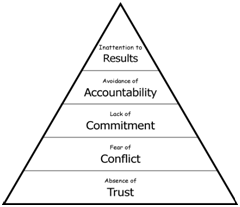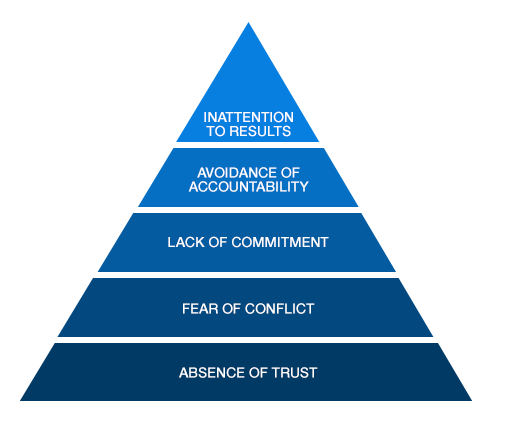Know about Five Dysfunctions of a Team Assessment

Five Dysfunctions of a Team
 The Five Behaviors of an Organizational Team are team-building exercises, which are designed to help an organization improve its ability to work successfully together. These behaviors are identified in the organizational culture and are presented in this paper as five interrelated but independent problems which impact upon the overall functioning of the organization.
The Five Behaviors of an Organizational Team are team-building exercises, which are designed to help an organization improve its ability to work successfully together. These behaviors are identified in the organizational culture and are presented in this paper as five interrelated but independent problems which impact upon the overall functioning of the organization.
The five behaviors of a Team Assessment is an exceptional team development tool because it is a comprehensive 38-question handout. A key component of this facilitator-led Five Dysfunctional Teams of an Organizational Team, the Team Analysis presents what the term implies “an individual assessment” of an organizational dysfunction instead of an individual self-evaluation. This individual assessment is undertaken as a group.
The Team Assessment also provides a framework within which the organization can develop new strategies and processes to address the behaviors identified in the questionnaire. However, a very important feature of this assessment is that it is done on the basis of observations from the entire organization. It is designed to collect data from many people who are involved in a specific team function. Because of this, the Team Assessment provides a great deal of information for the team to use in order to understand its own functions and its relationship with other teams within the organization.
The Team Assessment also provides information regarding the relationships among the behaviors within an organization. Team Building can improve the organization’s overall effectiveness by building stronger relationships among the team members. Therefore, the Five Dysfunctional Team Performance Questionnaire identifies the relationships among the individual team members within an organization, their strengths and weaknesses, and how they interact with one another.
Each Team Member’s contribution to the team and the impact each person has on the team are also identified. In the first part of the Five Dysfunctional Team Performance Questionnaire (TFQ), a questionnaire is given to the members of an organization. It asks questions about the types of challenges faced by the members of the team and the manner in which the members of that team to deal with these challenges.
The second part of the TFQ identifies the organizational values that the organizational team should adopt. It also provides a summary of the organization’s five most important organizational goals, which have been identified in the past. In addition to this, it describes the goals of the organization that must be met for the organization to become successful. Click here to know more.
In the third section of the TQ, each Team member’s performance in achieving the organizational goals is examined. Finally, the Five Dysfunctional Team Performance Questionnaire identifies the results of the organization’s performance against the defined organizational targets.
The team performance against the identified targets and the results of the assessment are then discussed in relation to one another. The final part of the Five Dysfunctional Team Performance Questionnaire (TFQ) is the evaluation of the activities, which has been completed by the team and the impact that these activities had on the achievement of the organization’s goals.
The team members will also receive a series of training sessions in which they are encouraged to learn more about the assessment process and the Five Dysfunctional Team Performance Questionnaire. At the conclusion of the training session, a final report is provided for the team to take home. This final report helps the participants to identify the areas in which they can improve and implement these improvements in order to improve their team performance.
In the fourth part of the TFQ, the participants are encouraged to consider the ways in which they can enhance the quality of their work, the satisfaction that they bring to the organization and the success that they attain in achieving the organizational objectives. They are also asked to provide feedback in relation to the way in which they improve their performance in achieving the team objectives. In addition to this, the participant is also asked to provide a summary of the areas in which they have developed strengths.
After the training sessions have ended, the team members are then asked to conduct a final analysis of the results of the assessments that they have conducted. The team members are asked to share their views and to identify those areas where they see improvement as well as those areas where they expect improvement. In addition to this, the final report is given to the leader or management who will be reviewing it.
The results of the Five Behaviors of a Team Training are extremely useful in helping a business to understand the problems that a team is facing and how to overcome them. The evaluation helps the leaders to identify the strengths of the team as well as identifying the areas in which the weaknesses are evident and how to overcome them.
For more details visit: https://www.discprofile.com/fac-sup/fac-tips/model#:~:text=The%20five%20behaviors%20Lencioni%20identified,previous%20and%20supports%20the%20others.
Read our other Career Articles.









